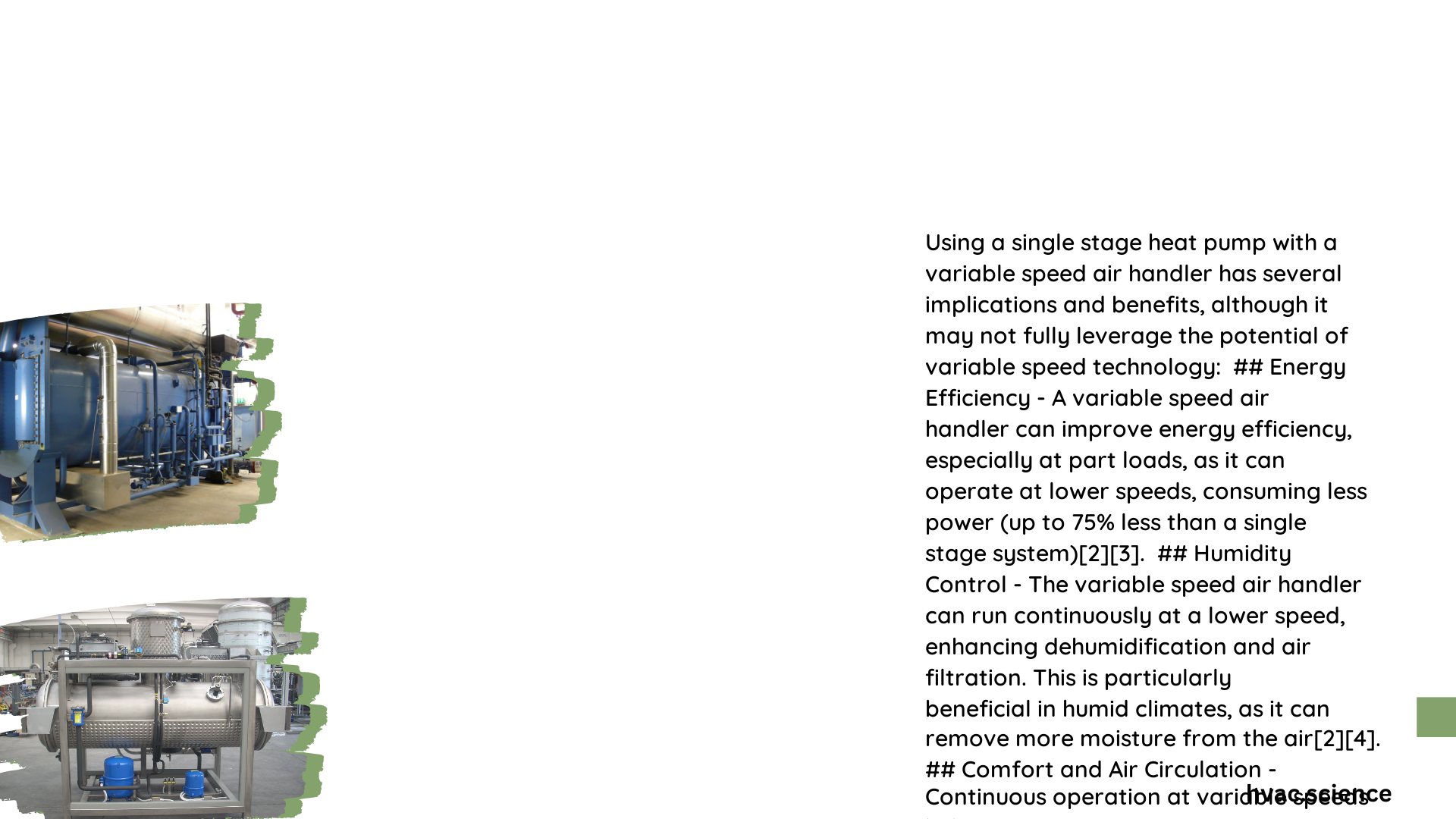A single stage heat pump with variable speed air handler combines the simplicity of a single-stage compressor with the advanced airflow control of a variable speed air handler. This system offers improved energy efficiency, better temperature control, and enhanced humidity management compared to traditional single-stage systems. The variable speed air handler allows for precise airflow modulation, reducing energy consumption and providing more consistent comfort throughout the home.
What are the Key Components of a Single Stage Heat Pump with Variable Speed Air Handler?
The main components of this system include:
- Single-stage compressor
- Variable speed air handler
- Indoor coil
- Outdoor coil
- Reversing valve
- Expansion device
- Thermostat (compatible with variable speed control)
The single-stage compressor operates at one fixed speed, while the variable speed air handler can adjust its fan speed to match the heating or cooling demand.
How Does the Efficiency Compare to Traditional Systems?

Efficiency Ratings
Single stage heat pumps with variable speed air handlers typically have the following efficiency ratings:
- SEER2 (Seasonal Energy Efficiency Ratio): 14 to 18
- HSPF2 (Heating Seasonal Performance Factor): 7.8 to 9.5
While these ratings are similar to traditional single-stage heat pumps, the variable speed air handler can enhance overall system efficiency.
Energy Consumption Comparison
The variable speed air handler offers several advantages in terms of energy consumption:
- Reduced short-cycling
- More consistent temperatures
- Improved humidity control
- Lower fan energy use during low-demand periods
These benefits can lead to overall energy savings compared to systems with single-speed air handlers, even though the compressor efficiency remains the same.
What are the Benefits of Using a Variable Speed Air Handler?
Improved Comfort
- Temperature Consistency: The ability to modulate airflow helps maintain more stable temperatures throughout the home.
- Humidity Control: Longer run times at lower speeds allow for better moisture removal from the air.
- Reduced Temperature Swings: The system can make small adjustments to airflow, preventing the large temperature fluctuations common with single-speed systems.
Quieter Operation
Variable speed air handlers typically operate more quietly than single-speed models due to:
- Gradual start-up and shut-down
- Lower average operating speeds
- Reduced ‘whoosh’ effect when air starts flowing
Enhanced Air Filtration
The variable speed operation allows for:
- Longer air circulation periods
- More air passing through the filter
- Improved indoor air quality
What are the Installation Costs and Potential Rebates?
Installation Costs
The cost to install a single stage heat pump with a variable speed air handler can vary widely based on factors such as:
- Equipment brand and model
- Home size and layout
- Existing ductwork condition
- Local labor rates
Here’s a rough breakdown of potential costs:
| Component | Cost Range |
|---|---|
| Heat Pump | $3,000 – $6,000 |
| Variable Speed Air Handler | $1,000 – $2,000 |
| Labor | $2,000 – $4,000 |
| Total | $6,000 – $12,000+ |
Potential Rebates and Incentives
To offset the installation costs, various rebates and incentives may be available:
- Federal tax credits for energy-efficient HVAC systems
- State-level incentives for heat pump installations
- Utility company rebates for high-efficiency systems
- Manufacturer rebates or promotional offers
The availability and amount of these incentives can vary by location and time, so it’s important to research current offers in your area.
What Compatibility Factors Should be Considered?
Model Compatibility
When selecting a single stage heat pump with a variable speed air handler, consider the following:
- Ensure the air handler is designed to work with single-stage heat pumps
- Verify that the control board in the air handler is compatible with the heat pump model
- Check if the manufacturer offers matched systems for optimal performance
Ductwork Requirements
The existing ductwork may need evaluation and possible modifications:
- Size: Ducts should be properly sized to handle the variable airflow rates
- Sealing: Well-sealed ducts are crucial for efficient operation
- Insulation: Proper insulation helps maintain temperature consistency
Thermostat Compatibility
A compatible thermostat is essential for proper system control:
- Must be able to communicate with the variable speed air handler
- Should have settings for fan speed control
- May require additional wiring compared to basic thermostats
How Does Maintenance Differ from Traditional Systems?
Maintenance for a single stage heat pump with variable speed air handler is similar to traditional systems, with a few additional considerations:
- Filter Changes: More frequent checks may be necessary due to longer run times
- Coil Cleaning: Regular cleaning is crucial for maintaining efficiency
- Control Board Inspection: The variable speed control board should be checked for proper operation
- Airflow Adjustments: Periodic airflow checks and adjustments may be needed to ensure optimal performance
Regular maintenance by a qualified HVAC technician is recommended to keep the system operating at peak efficiency.
What are the Long-Term Cost Implications?
While the initial cost of a single stage heat pump with variable speed air handler may be higher than a traditional system, several factors can lead to long-term savings:
- Energy Efficiency: Lower operating costs due to improved efficiency
- Comfort Improvements: Reduced need for supplemental heating or cooling
- System Longevity: Potentially longer lifespan due to reduced wear and tear
- Fewer Repairs: Less stress on components may lead to fewer breakdowns
Over time, these factors can offset the higher initial investment, making the system a cost-effective choice for many homeowners.
By combining the simplicity of a single-stage heat pump with the advanced capabilities of a variable speed air handler, this system offers a balance of efficiency, comfort, and cost-effectiveness for residential heating and cooling needs.
